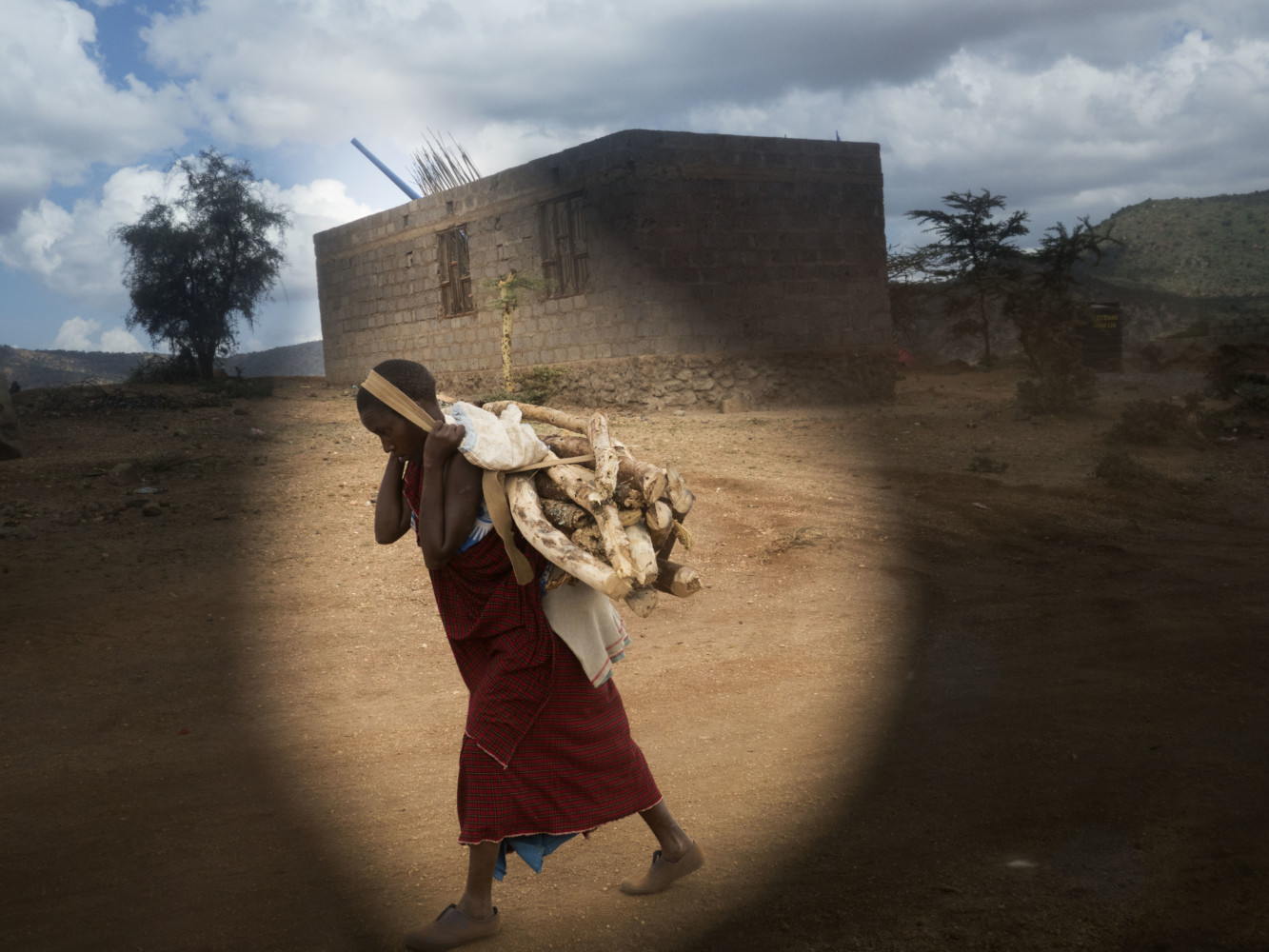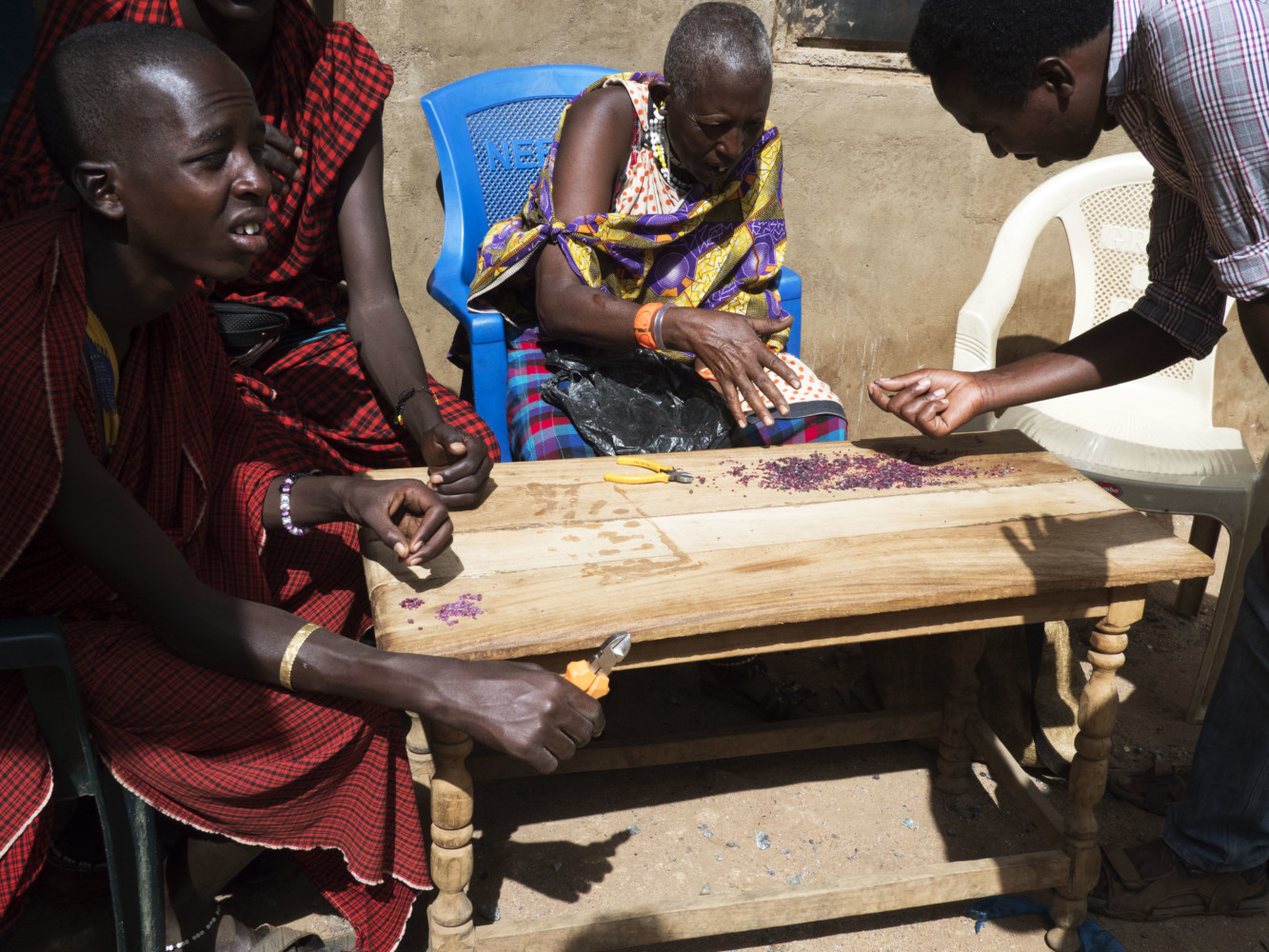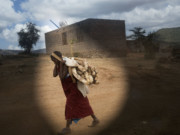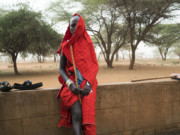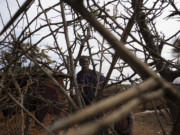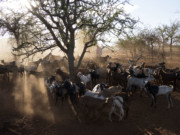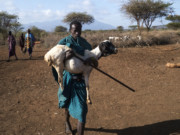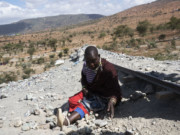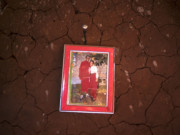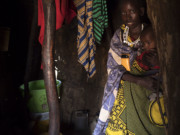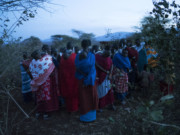Thomas Dworzak Carrying firewood. In 2016/4 ruby was discovered in the village of Mundarara, a traditional poor Maasai grazing area. Since then there has been a boom of ruby exploration, locals and arriving trade (...)
rs, but also an increase in evictions from the land where ruby can be found. Longido area, Arusha Region, Tanzania. 2018/02.
© Thomas Dworzak/Magnum Photos with support from the Pulitzer Center © Thomas Dworzak | Magnum Photos
Thomas Dworzak Maasai cattle market, mostly for sheep and goats. Due to landgrab the distances between their place of living, herding and trading have increased, demanding more hours of walking in between. At thi (...)
s market close to the Kenyan border crossing Maasai organized themselves to sell their cattle to mostly Kenyan buyers. Namanga, Arusha Region, Tanzania. 2018/02. © Thomas Dworzak/Magnum Photos with support from the Pulitzer Center © Thomas Dworzak | Magnum Photos
Thomas Dworzak Maasai cattle market, mostly for sheep and goats. Due to landgrab the distances between their place of living, herding and trading have increased, demanding more hours of walking in between. At thi (...)
s market close to the Kenyan border crossing Maasai organized themselves to sell their cattle to mostly Kenyan buyers. Namanga, Arusha Region, Tanzania. 2018/02. © Thomas Dworzak/Magnum Photos with support from the Pulitzer Center © Thomas Dworzak | Magnum Photos
Thomas Dworzak Obomba Boma, Maasai village. Family of Maasai father who is trying to be part of the new Ruby boom, at the same time there has been an increase of evictions due to land grab in their area. In 2016 (...)
/4 Ruby was discovered in the village of Mundarara, a traditional poor Maasai grazing area. Since then there has been a boom of ruby exploration, locals and arriving traders, but also an increase in evictions from the land where ruby can be found. Longido area, Arusha Region, Tanzania. 2018/02. © Thomas Dworzak/Magnum Photos with support from the Pulitzer Center © Thomas Dworzak | Magnum Photos
Thomas Dworzak Eworendeke village. Maasai preparing the slaughtering of a sheep to ask for rain. A recent drought and the dislocation of their traditional grazing land has created difficulties, e.g. there are pra (...)
ctically no more cows, harder to feed. Namanga, Arusha Region, Tanzania. 2018/02.
© Thomas Dworzak/Magnum Photos with support from the Pulitzer Center © Thomas Dworzak | Magnum Photos
Thomas Dworzak TANZANIA, Arusha Region, Longido area 2018/02. Exploring ruby next to a recently built mine. In 2016/4 ruby was discovered in the village of Mundarara, a traditional poor Maasai grazing area. Since (...)
then there has been a boom of ruby exploration, locals and arriving traders, but also an increase in evictions from the land where ruby can be found.
(Obligatory Credit: The credit for this image must read as "© Thomas Dworzak/Magnum Photos with support from the Pulitzer Center”) © Thomas Dworzak | Magnum Photos
Thomas Dworzak Exploring ruby next to a recently built mine. In 2016/4 ruby was discovered in the village of Mundarara, a traditional poor Maasai grazing area. Since then there has been a boom of ruby exploration (...)
, locals and arriving traders, but also an increase in evictions from the land where ruby can be found. Longido area, Arusha Region, Tanzania. 2018/02. © Thomas Dworzak/Magnum Photos with support from the Pulitzer Center © Thomas Dworzak | Magnum Photos
Thomas Dworzak Maasai local ruby traders. In 2016/4 ruby was discovered in the village of Mundarara, a traditional poor Maasai grazing area. Since then there has been a boom of ruby exploration, locals and arrivi (...)
ng traders, but also an increase in evictions from the land where ruby can be found. Longido area, Arusha Region, Tanzania. 2018/02. © Thomas Dworzak/Magnum Photos with support from the Pulitzer Center © Thomas Dworzak | Magnum Photos
Thomas Dworzak TANZANIA, Arusha Region, Longido area 2018/02. Maasai women group meeting to discuss the effects of the ruby boom and evictions. In 2016/4 ruby was discovered in the village of Mundarara, a tradit (...)
ional poor Maasai grazing area. Since then there has been a boom of ruby exploration, locals and arriving traders, but also an increase in evictions from the land where ruby can be found.
(Obligatory Credit: The credit for this image must read as "© Thomas Dworzak/Magnum Photos with support from the Pulitzer Center”) © Thomas Dworzak | Magnum Photos
Thomas Dworzak TANZANIA, Arusha Region, Namanga 2018/02. Eworendeke village. Maasai family. The couple had both studied teaching in Arusha and gotten used to a more modern livestyle but had to move back to the v (...)
illage, unable to get a established there.
(Obligatory Credit: The credit for this image must read as "© Thomas Dworzak/Magnum Photos with support from the Pulitzer Center”) © Thomas Dworzak | Magnum Photos
Thomas Dworzak Maasai husband of two wives. He was evicted by a combination of government and commercial deal, by force and his hut destroyed. Had to move 10km inland. But also is successfully involved in the rub (...)
y business and has been able and continues building a house, restaurant etc. in the center of the booming village. In 2016/4 ruby was discovered in the village of Mundarara, a traditional poor Maasai grazing area. Since then there has been a boom of ruby exploration, locals and arriving traders, but also an increase in evictions from the land where ruby can be found. Longido area , Arusha Region, Tanzania. 2018/02. © Thomas Dworzak/Magnum Photos with support from the Pulitzer Center © Thomas Dworzak | Magnum Photos
Thomas Dworzak Eworendeke village. Maasai women preparing the slaughtering of a sheep to ask for rain. A recent drought and the dislocation of their traditional grazing land has created difficulties, e.g. there a (...)
re practically no more cows, harder to feed. Namanga, Arusha Region, Tanzania. 2018/02. © Thomas Dworzak/Magnum Photos with support from the Pulitzer Center © Thomas Dworzak | Magnum Photos
Thomas Dworzak Ruby collectors, In 2016/4 ruby was discovered in the village of Mundarara, a traditional poor Maasai grazing area. Since then there has been a boom of ruby exploration, locals and arriving traders (...)
, but also an increase in evictions from the land where ruby can be found. Longido area, Arusha Region, Tanzania. 2018/02. © Thomas Dworzak/Magnum Photos with support from the Pulitzer Center © Thomas Dworzak | Magnum Photos
Thomas Dworzak Restaurant catering to mostly Maasai herders and traders who come to the weekly community market. In 2016/4 ruby was discovered in the village of Mundarara, a traditional poor Maasai grazing area. (...)
Since then there has been a boom of ruby exploration, locals and arriving traders, but also an increase in evictions from the land where ruby can be found. Longido area, Arusha Region, Tanzania. 2018/02. © Thomas Dworzak/Magnum Photos with support from the Pulitzer Center © Thomas Dworzak | Magnum Photos
Thomas Dworzak Eworendeke village. Head of women's group. Maasai women preparing the slaughtering of a sheep to ask for rain. A recent drought and the dislocation of their traditional grazing land has created dif (...)
ficulties, e.g. there are practically no more cows, harder to feed. Namanga, Arusha Region, Tanzania. 2018/02. © Thomas Dworzak/Magnum Photos with support from the Pulitzer Center © Thomas Dworzak | Magnum Photos
